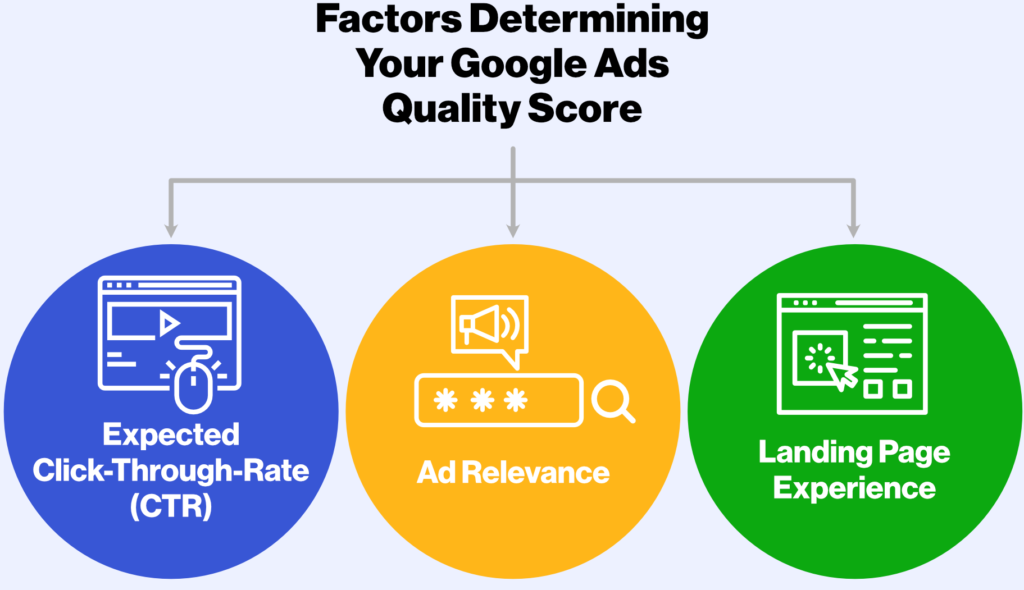Mastering and improving your Google Ads Quality Score is crucial for the success of your online advertising campaigns. If you’re looking to boost your website visibility, enhance ad performance, and drive more conversions, then understanding and optimizing your Quality Score is a must!
In this guide, we’ll take you through everything you need to know about Google Ads Quality Score – from what it is to why it’s important, factors that influence it, how to measure and monitor it, effective strategies for improvement, and common mistakes to avoid. Let’s dive right in!
What is Google Ads Quality Score?
Google Ads Quality Score is a metric used by Google to determine the relevance and quality of your ads. It is rated on a scale from 1 to 10, with 10 being the highest score. Essentially, it measures how well your ads align with users’ search queries.
A high Quality Score indicates that your ad campaign is delivering relevant and valuable information to users, resulting in higher visibility and lower costs per click. On the other hand, a low Quality Score means that your ads are not meeting users’ expectations or aren’t matching their search intent.
To calculate the Quality Score, Google considers several factors including click-through rate (CTR), ad relevance, landing page experience, and historical account performance. These elements help Google evaluate how likely it is for your ad to generate positive user engagement.
The importance of having a High-Quality Score cannot be overstated. Not only does it affect where your ads appear on search engine results pages (SERPs), but it also determines how much you’ll pay for each click. A higher Quality Score can lead to better ad positions at lower costs.
By optimizing these factors that influence Quality Score such as creating compelling ad copy, using relevant keywords, improving landing page experience, and continuously monitoring performance metrics like CTR and conversion rates; you can improve your overall score over time.
Remember that while achieving a perfect 10 might seem like an ideal goal – realistically speaking – maintaining scores above average within specific industries should be prioritized instead. This will help ensure you’re consistently providing value to potential customers while maximizing returns on advertising investment.
Understanding what influences Google Ads Quality Score sets the foundation for successful optimization strategies in later sections of this guide. So now that we have covered what exactly this scoring system entails let’s explore some essential tactics for measuring and monitoring quality score effectively!
The Importance of a High-Quality Score
A high-quality score in Google Ads is crucial for the success of your advertising campaigns. It directly impacts the cost and effectiveness of your ads, as well as your overall account performance. A high-quality score means that Google perceives your ad to be relevant and valuable to users, resulting in lower costs per click (CPC) and higher ad rankings.
A high-quality score leads to lower CPCs. When you have high relevancy between your keywords, ad copy, and landing page experience, Google rewards you with discounted clicks. This means that you can achieve better results while spending less money on each click.
A high-quality score improves your ad rank. Ad rank determines where your ads appear on the search engine results page (SERP). With a higher position on the SERP, you are more likely to attract clicks from potential customers.
A high-quality score positively affects other important metrics like impressions and conversion rates. When Google sees that users find value in your ads through engagement metrics such as click-through rate (CTR), it rewards you by showing them more frequently. Additionally, if users find what they are looking for on your landing page after clicking an ad, they are more likely to convert into customers.

Factors that Affect Quality Score
The Google Ads Quality Score is influenced by several key factors. Understanding these factors can help you optimize your campaigns and improve your quality score.
1. Keywords: The relevance of your keywords to the search query plays a significant role in determining your quality score. Choose keywords that closely match the intent of potential customers.
2. Ad Relevance: How well your ads align with the keywords and landing page content affects your quality score. Ensure that your ad copy contains relevant keywords and provides a clear message to users.
3. Landing Page Experience: The user experience on your landing page is crucial for achieving a high-quality score. Make sure it loads quickly, has relevant content, and offers a seamless browsing experience.
4. Click-Through Rate (CTR): A higher CTR indicates that users find value in clicking on your ads, which positively impacts the quality score. Create compelling ad text and target specific audiences to increase CTR.
5. Historical Account Performance: Your account’s historical performance also influences the quality score. Consistently monitoring and optimizing campaigns can lead to improved performance over time.
6. Relevance across Devices: With more people accessing the internet through different devices, ensuring that your ads are optimized for mobile can impact both user experience and quality scores.
Understanding these factors will allow you to strategically optimize each aspect of your Google Ads campaign for an improved quality score
How to Measure and Monitor Your Quality Score
Measuring and monitoring your Quality Score is crucial for optimizing the performance of your Google Ads campaigns. It allows you to gauge the effectiveness of your ad relevance, landing page experience, and expected click-through rate (CTR).
To measure your Quality Score, navigate to the Keywords tab in your Google Ads account. Here, you’ll find a column labeled “Quality Score” that provides a score ranging from 1 to 10. The higher the score, the better.
Monitoring your Quality Score involves regularly checking its fluctuations over time. This can help identify any changes or trends that may impact campaign performance. You can view historical data by customizing reports or using third-party tools.
In addition to monitoring overall scores, it’s essential to assess individual keyword-level scores. By identifying keywords with low scores, you can take targeted actions such as improving ad relevance or enhancing landing page experiences.
Remember that Quality Scores are dynamic and can change frequently based on various factors like competitors’ actions and user behavior. Therefore, continuous monitoring is key to maintaining optimal campaign performance.
Stay tuned for our next blog section where we will discuss effective strategies for improving your Quality Score!
Strategies for Improving Quality Score
1. Target Relevant Keywords: One of the most effective ways to improve your quality score is by targeting relevant keywords in your ads. Conduct thorough keyword research and choose keywords that are highly relevant to your ad campaign and landing page.
2. Create Compelling Ad Copy: Your ad copy plays a crucial role in determining your quality score. Craft compelling, concise, and targeted ad copy that aligns with the keywords you’re targeting. This will not only help increase click-through rates but also improve the overall relevancy of your ads.
3. Optimize Landing Pages: A well-optimized landing page can significantly impact your quality score. Ensure that your landing pages provide a seamless user experience, load quickly, and are mobile-friendly. Make sure the content on the landing page aligns with the keywords you’re targeting in your ads.
4. Improve Click-Through Rates (CTR): Higher CTRs indicate that users find your ads helpful and relevant, which positively affects the quality score. To boost CTR, consider using ad extensions like sitelinks or callouts to provide additional information or incentives to potential customers. We have also unlocked the secret of how ad extensions can significantly boost CTR and Engagements.
5. Test Different Ad Variations: Continuously test different variations of your ads to identify what works best for improving click-through rates and conversion rates while maintaining high relevancy.
Remember, improving quality score takes time and effort as it involves optimizing various elements such as keyword selection, ad copywriting, landing page design, and more.
Common Mistakes to Avoid
In your quest to master and improve your Google Ads Quality Score, it’s important to be aware of common mistakes that can hinder your progress. By avoiding these pitfalls, you’ll be on the right track toward achieving a high-quality score.
1. Neglecting Keyword Research: One mistake to avoid is neglecting keyword research. Choosing relevant keywords that align with your ads and landing pages is crucial for a strong quality score. Without proper keyword selection, you may end up targeting the wrong audience or providing irrelevant information, which can negatively impact your score.
2. Failing to Optimize Ad Relevance: Create compelling ad copy that directly relates to the keywords being targeted. Ensure alignment between keywords, ad text, and landing pages to improve user experience and increase the likelihood of conversions.
3. Directing users to irrelevant landing pages: Avoid directing users to generic or irrelevant landing pages that don’t provide value or meet their expectations. Instead, focus on creating landing pages with clear messaging and user-friendly design that encourage visitors to take action.
4. Ignoring click-through rate (CTR): CTR measures how often people click on your ads after seeing them. It’s an important indicator of ad performance and relevance. Low CTRs indicate poor ad engagement and may result in lower quality scores over time.
Conclusion: Mastering Google Ads Quality Score takes time and effort but yields substantial benefits in terms of cost savings and improved campaign performance. By understanding what affects quality score metrics like expected click-through rate (CTR), ad relevance and landing Page Experience – monitoring them regularly will help identify areas for improvement.


